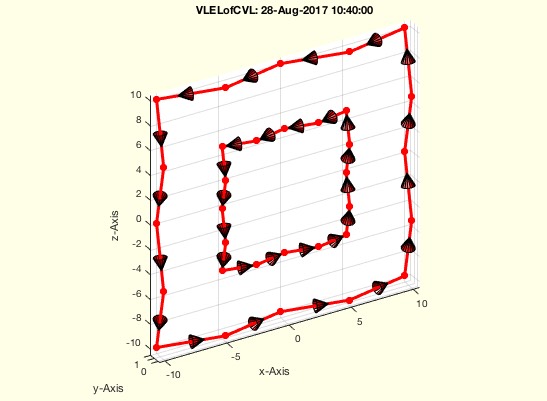VLELofCVL
by Tim C. Lueth, SG-Lib Toolbox: SolidGeometry 5.6 - Auxiliary function
Introduced first in SolidGeometry 4.1, Creation date: 2017-08-27, Last change: 2025-09-14
converts nan separated succeeding vertex lists into a vertex list and an edge list
Description
This function removes the NaN from the original point list. The orientation (cw/ccw) is not changed. It is exactly the same as PLELofCPL
See Also: ELofCVL
, PLELofCPL
, CVLofVLEL
Example Illustration

Syntax
[VL,EL]=VLELofCVL(CVL)
Input Parameter
CVL: | | NAN Separated Vertex List |
Output Parameter
VL: | | Vertex List (without NaN) |
EL: | | Edge list |
Examples
[VL,EL]=VLELofCVL(VLsample(19)); CVL=CVLofVLEL(VL,EL); VLELofCVL(VLsample(19));
Copyright 2017-2025 Tim C. Lueth. All rights reserved. The code is the property of Tim C. Lueth and may not be redistributed or modified without explicit written permission. This software may be used free of charge for academic research and teaching purposes only. Commercial use, redistribution, modification, or reverse engineering is strictly prohibited. Access to source code is restricted and granted only under specific agreements. For licensing inquiries or commercial use, please contact: Tim C. Lueth
Algorithm (Workflow)
This function, VLELofCVL, is designed to convert a NaN-separated vertex list (CVL) into a vertex list (VL) and an edge list (EL). It is part of the SolidGeometry library and was introduced in version 4.1.
Input Parameters
- CVL: A NaN-separated vertex list. This list contains vertices separated by NaN values, which indicate breaks between different sets of vertices.
Output Results
- VL: A vertex list without NaN values. This list contains all the vertices from the input CVL, but with the NaN values removed.
- EL: An edge list. This list defines the edges between the vertices in the VL.
Algorithm Steps
- The function calls
PLELofCPL with the input CVL. This function is responsible for removing NaN values and generating the vertex and edge lists.
- If no output arguments are specified (i.e.,
nargout==0), the function will create a 3D plot of the vertices and edges using the SGfigure and VLELplots functions.
- The view for the plot is set to an angle of -30 degrees in azimuth and 30 degrees in elevation.
- The size of the plot markers is determined by the bounding box size, calculated using
sofBB(BBofVL(VL)), and scaled by a factor of 1/20.
Example Usage
An example of how to use this function is provided in the comments:
[VL,EL]=VLELofCVL(VLsample(19));
CVL=CVLofVLEL(VL,EL);
VLELofCVL(VLsample(19));
This example demonstrates converting a sample vertex list into a CVL and back into a VL and EL.
Algorithm explaination created using ChatGPT on 2025-08-18 23:34. (Please note: No guarantee for the correctness of this explanation)
Last html export of this page out of FM database by TL: 2025-09-21